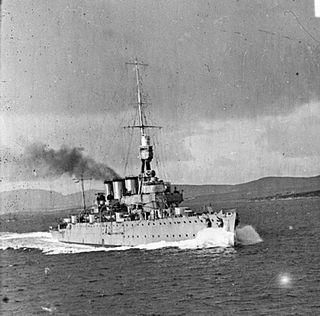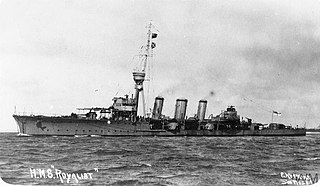Design and description
Based on the Birmingham sub-class of the Towns, the two Greek ships primarily differed from their British half-sisters in their armament. The Greeks specified that they would use the new BL 5.5-inch (140 mm) Mk I gun built by the Coventry Ordnance Works. This weapon was significantly lighter than the standard 6-inch (152 mm) gun, which allowed the ships to mount ten guns, rather than the nine of the Birminghams, and fired an 85-pound (39 kg) shell rather than the 100-pound (45 kg) shell of the 6-inch weapon. It therefore had a higher rate of fire with little loss in hitting power. [1] The Greeks also specified a secondary armament of two 12-pounder anti-aircraft guns, but these were still under development in 1915 and a pair of 3-pounder guns on high-angle mounts were substituted instead. [2]
Birkenhead was 456 feet 6 inches (139.1 m) long overall, with a beam of 49 feet 10 inches (15.2 m) and a draught of 15 feet 3 inches (4.6 m). [3] Displacement was 5,235 long tons (5,319 t ) normal and 5,845 long tons (5,939 t) at full load. Twelve Yarrow boilers fed Birkenhead's Parsons steam turbines, driving four propeller shafts, that were rated at 25,000 shaft horsepower (19,000 kW) for a design speed of 25.5 knots (47.2 km/h; 29.3 mph). The boilers used both fuel oil and coal, with 1,070 long tons (1,087 t) of coal and 352 long tons (358 t) tons of oil carried. [1]
Two of the 5.5-inch guns were mounted on the centreline fore and aft of the superstructure and the remaining eight guns were positioned on the broadside. All these guns were fitted with gun shields. Two Vickers 3-pounder (47 mm) anti-aircraft guns were also fitted. The armament was completed by two submerged 21-inch (533 mm) torpedo tubes. [4]
Service
The ship was laid down as Yard number 809 on 27 March 1914. Despite the outbreak of the First World War in August 1914, Greece continued to pay for the two cruisers, and construction continued for Greece, with Antinavarhos Kountoriotis being launched on 18 January 1915. [5] [6] However, with the war dragging on with no sign of a quick result, the Admiralty soon decided to purchase the two ships, with Antinavarhos Kountoriotis being renamed Birkenhead. [1] [7] She was completed in July 1915. [6]
Like her sister, Chester, Birkenhead was assigned to the 3rd Light Cruiser Squadron of the Grand Fleet. [8] On 26 September 1915, the accommodation ship Caribbean got into difficulties in heavy weather off Cape Wrath when on passage to Scapa Flow. On receipt of Caribbean's distress signals, Birkenhead set out from Scapa to assist, and together with several tugs and yachts, rescued all but 15 of Caribbean's crew before the accommodation ship sank on the next morning. [9] Birkenhead continued her work-up and training before formally joining the 3rd Light Cruiser Squadron on 6 November. [10] On 31 May to 1 June 1916, Birkenhead and Chester both took part in the Battle of Jutland. Birkenhead survived the battle, and the war [1] and was sold for scrap on 26 October 1921 to Cashmore, of Newport. [11]

HMS Neptune was a dreadnought battleship built for the Royal Navy in the first decade of the 20th century, the sole ship of her class. She was the first British battleship to be built with superfiring guns. Shortly after her completion in 1911, she carried out trials of an experimental fire-control director and then became the flagship of the Home Fleet. Neptune became a private ship in early 1914 and was assigned to the 1st Battle Squadron.

The Town class was a group of twenty-one light cruisers built for the Royal Navy (RN) and Royal Australian Navy (RAN) of the first half of the 20th century. These vessels were long-range cruisers, suitable for patrolling the vast expanse covered by the British Empire. These ships, initially rated as second class cruisers, were built to a series of designs, known as the Bristol, Weymouth, Chatham, Birmingham and Birkenhead classes – all having the names of British towns except for the RAN ships, which were named after Australian cities.

HMS Galatea was one of eight Arethusa-class light cruisers built for the Royal Navy in the 1910s. She fought in the First World War, participating in the Battle of Jutland. Following the war, she was scrapped.

The Arethusa-class cruisers were a class of eight oil-fired light cruisers of the Royal Navy all ordered in September 1912, primarily for service in the North Sea. They had three funnels with the middle one somewhat larger in diameter than the others. All served in the First World War. They were found to be very cramped internally.

HMS Britannia was a King Edward VII-class pre-dreadnought battleship of the Royal Navy. She was named after Britannia, the Latin name of Great Britain under Roman rule. The ship was built by Portsmouth Dockyard between 1904 and 1906. Armed with a battery of four 12-inch (305 mm) and four 9.2 in (234 mm) guns, she and her sister ships marked a significant advance in offensive power compared to earlier British battleship designs that did not carry the 9.2 in guns.

HMS Southampton was a Town-class light cruiser built for the Royal Navy in the 1910s. She was a member of the Chatham sub-class of the Town class. The ship survived the First World War and was sold for scrap in 1926.

HMS Birmingham was lead ship of the Birmingham group of three ships of the Town-class of light cruisers built by the Royal Navy. Her sister ships were Lowestoft and Nottingham. The three ships were virtually identical to the third group of Town-class ships, but with an additional 6 in (150 mm) gun worked in on the forecastle.

HMS Chester was a Town-class light cruiser of the Royal Navy, one of two ships forming the Birkenhead subtype. Along with sister ship, Birkenhead, she was originally ordered for the Greek Navy in 1914 and was to be named Lambros Katsonis. The order was placed with Cammell Laird and production continued for the Greek account after the outbreak of the First World War in August 1914. In 1915 the two cruisers were purchased by the British government. She fought at the Battle of Jutland where casualties included John 'Jack' Cornwell who was awarded the highest honour, aged 16.

HMS Nottingham was a Town-class light cruiser built for the Royal Navy just before World War I. She was one of three ships of the Birmingham sub-class and was completed in early 1914. The ship was assigned to the 1st Light Cruiser Squadron (LCS) of the Home and Grand Fleets for her entire career. Nottingham participated in most of the early fleet actions, including the battles of Heligoland Bight, Dogger Bank, and Jutland, helping to sink several German ships during the battles. The ship was sunk by the German submarine U-52 during the Action of 19 August 1916.

HMS Shannon was a Minotaur-class armoured cruiser built for the Royal Navy in the mid-1900s. Before the First World War, she served with the Home Fleet, generally as the flagship of a cruiser squadron. The ship remained with the Grand Fleet, as the Home Fleet was renamed when the war began, for the entire war, but only participated in a single battle, the Battle of Jutland in May 1916. Shannon spent most of the war unsuccessfully patrolling the North Sea for German warships and commerce raiders. She was paid off in 1919 and sold for scrap in 1922.

HMS Inconstant was one of eight Arethusa-class light cruisers built for the Royal Navy in the 1910s. She fought in the First World War, participating in the Battle of Jutland. Following the war, she was scrapped.

HMS Phaeton was one of eight Arethusa-class light cruisers built for the Royal Navy in the 1910s. She fought in the First World War, participating in the Battle of Jutland. Following the war, she was scrapped.

HMS Royalist was one of eight Arethusa-class light cruisers built for the Royal Navy in the 1910s. She fought in the First World War, participating in the Battle of Jutland. Following the war, she was scrapped.

HMS Gloucester was a Town-class light cruiser built for the Royal Navy in the first decade of the 20th century. The ship was initially assigned to the Home Fleet upon commissioning in 1910 and was transferred to the Mediterranean Fleet in 1913. She was involved in the hunt for the German ships Goeben and Breslau after World War I began in August 1914. Gloucester was detailed several times during the war to search for German commerce raiders, but her only success was the capture of one supply ship in early 1915. She played a minor role in the Battle of Jutland in mid-1916 and then spent most of the rest of the war in the Adriatic Sea. The ship was placed in reserve in 1919 and was sold for scrap in 1921.

HMS Weymouth was a Town-class light cruiser built for the Royal Navy during the 1910s. She was the name ship of the Weymouth sub-class of the Town class. The ship survived the First World War and was sold for scrap in 1928.

HMS Falmouth was a Town-class light cruiser built for the Royal Navy during the 1910s. She was one of four ships of the Weymouth sub-class. The ship was initially assigned to the Atlantic Fleet upon completion in 1911, but was reduced to reserve in mid-1913. When the First World War began in 1914, Falmouth was transferred to the 1st Light Cruiser Squadron (LCS) of the Grand Fleet and then the 3rd Light Cruiser Squadron at the end of the year. The ship participated in most of the early fleet actions, including the Battles of Heligoland Bight, Dogger Bank, and Jutland, but was only seriously engaged in the latter. She was torpedoed and sunk off Flamborough Head, Yorkshire by German submarines during the action of 19 August 1916.

HMS Lowestoft was a Town-class light cruiser built for the Royal Navy in the 1910s. She was a member of the Birmingham sub-class of the Town class. She survived World War I and was sold for scrap in 1931.

The Active-class cruisers were a trio of scout cruisers built for the Royal Navy shortly before the First World War. They were initially assigned to the First Fleet and became destroyer flotilla leaders in 1914. Amphion and Fearless and their flotillas were assigned to the Harwich Force when the war began in August 1914. They went out on a patrol on the first day of the war and Amphion and her destroyers encountered and sank a German minelayer. On the voyage home, the cruiser struck a mine laid by the German ship and sank. She was the first ship of the Royal Navy to be sunk in the war.

The Pathfinder-class cruisers were a pair of scout cruisers built for the Royal Navy in the first decade of the 20th century. The sister ships spent much of the first decade of their careers in reserve. When the First World War began in August 1914 they were given coastal defence missions, Pathfinder on the coast of Scotland and Patrol on the coast of Yorkshire. The latter ship was badly damaged when the Germans bombarded Hartlepool in December. She spent the rest of the war in British waters. The ship was paid off in 1919 and sold for scrap the following year. Pathfinder was sunk by a German submarine shortly after the war began, the first sinking of a British warship during the war by a German submarine.

HMS Kempenfelt was a Marksman-class flotilla leader of the British Royal Navy. She was built by the Cammell Laird at their Birkenhead shipyard, with construction starting in 1914 and completed in August 1915. She served through the remainder of the First World War. She was sold for scrap in 1921.


















